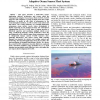52 search results - page 8 / 11 » Neural Fields for Controlling Formation of Multiple Robots |
ICRA
2009
IEEE
13 years 6 months ago
2009
IEEE
For haptic devices, compensation of the robot's gravity is a frequent strategy with the aim to reduce interaction forces between robot and human in zero-impedance control. How...
ICRA
2008
IEEE
14 years 3 months ago
2008
IEEE
– This paper describes a multi-robot science exploration software architecture and system called the Telesupervised Adaptive Ocean Sensor Fleet (TAOSF). TAOSF supervises and coor...
HASE
2007
IEEE
14 years 2 months ago
2007
IEEE
During the past several years, the area of robot service and multi-robot has grown rapidly. Since this area is a fusion industry consisting of multiple disciplines, it is lack of ...
MVA
1998
13 years 10 months ago
1998
Current NASA plans call for extended year-long, multikilometer treks for the 2003 and 2005 Mars missions. A much greater amount of rover autonomy is required compared to the recen...
ICANN
2010
Springer
13 years 7 months ago
2010
Springer
Trajectory formation is one of the basic functions of the neuromotor controller. In particular, reaching, avoiding, controlling impacts (hitting), drawing, dancing and imitating ar...

